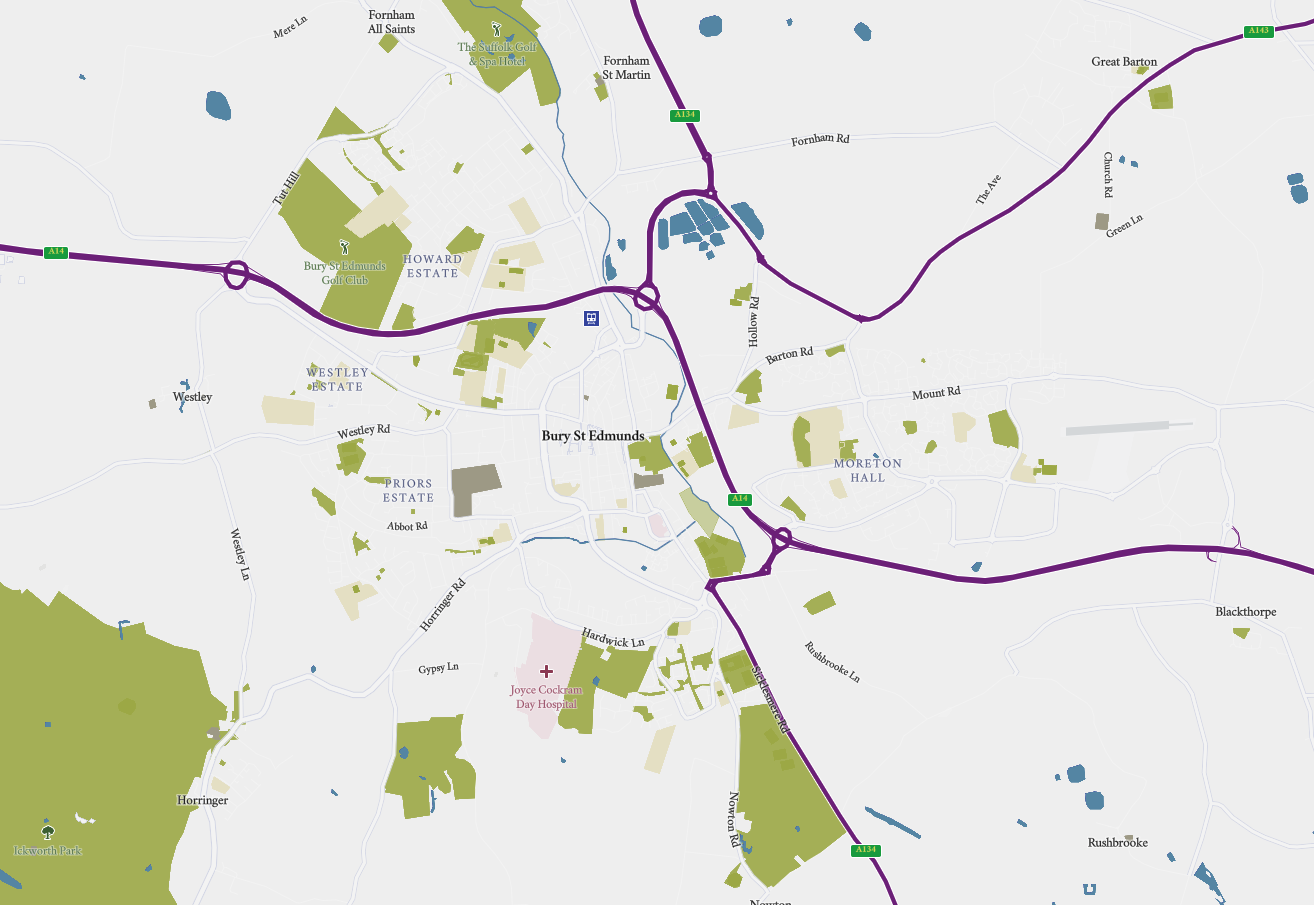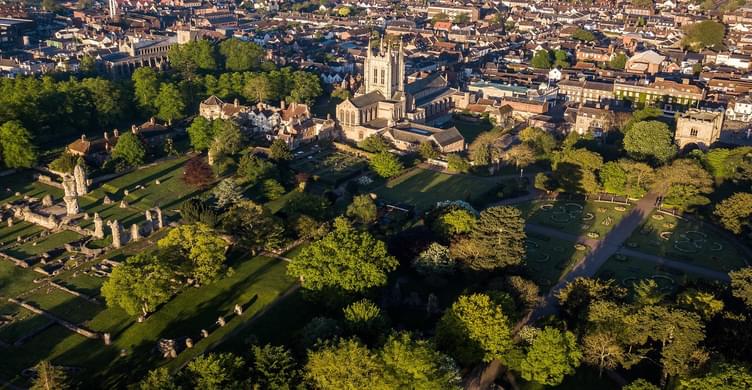About this Business
In Medieval times, The Abbey of St Edmund was one of the richest, largest and most powerful Benedictine monasteries in England. People came from all over England and Europe to visit the Shrine of St Edmund and it became one of the most famous and wealthy pilgrimage locations in England, visited by royalty.
Edmund, King of East Anglia, was killed by The Danes on 20 November 869, after refusing to give up his Christian faith. He was tied to a tree and shot full of arrows before being beheaded.
In 903 the remains of Saint Edmund, the original the Patron Saint of England, were moved to the Anglo-Saxon settlement of Beodericsworth (later known as Bury St Edmunds) where the site had already been in religious use for nearly three centuries.
St Edmund’s body was moved to London in 1010 for safe keeping when The Danes were again marauding through East Anglia but three years later his body was returned to Bedricesworth.
In 1020, King Cnut had a stone church built for Edmund's body and the first abbots arrived. This was the beginning of the Abbey of St Edmund, 1000 years ago, and it became a site of great pilgrimage as people from all over Europe came to visit St Edmund’s shrine.
Abbot Baldwin
In 1081, Abbot Baldwin embarked on a building programme that was to last well over 100 years, culminating in a Romanesque Abbey church. He was also responsible for laying out the town in 1065, which is considered the oldest purposefully laid out town in the country, the medieval grid is still evident today. The monks charged tariffs on every economic activity, including the collecting of horse droppings in the streets! The Abbey even had the power to mint its own coinage.
The great Abbey church was consecrated in 1095 and the bejewelled shrine of St Edmund stood behind the high altar. The Abbey church’s final length was 505 feet (154 metres) with the majestic West Front 246 feet (75 metres). At over 150 metres long the church was one of only a few of its date to be built on such a large scale in this country.
Abbot Samson
During the abbacy of Abbot Samson (1182 - 1211) Moyse’s Hall (now the town’s museum) was built and the wonderful Bury Bible by master Hugo was written.
Hugo may also be responsible for carving the Bury St Edmunds Cross - an unusually complex 12th-century Romanesque altar cross, carved from walrus ivory, now on display at the Metropolitan Museum of Art in New York. A replica is on display in St Edmundsbury Cathedral Treasury.
Much is known about Abbot Samson from The Chronicle of Joscelin De Brakeland, a monk of the abbey who kept a diary towards the end of 12th Century.
The Abbey and The Magna Carta
Near the ruins of the Abbey of St Edmunds, nestled in the Abbey Gardens, is ‘Our Liberty’, a lasting memorial to Bury St Edmunds’ link to the Magna Carta.
The Magna Carta is widely recognised as one of the most important documents in the world and Bury St Edmunds played a very crucial role in its creation.
A group of Barons met at the Abbey in 1214 and swore an oath to compel King John to accept the Charter of Liberties, a proclamation of Henry I. The most likely date for this meeting is November 20, 1214 because that was St Edmund’s Day. This act led directly to the Great Charter or the Magna Carta, agreed at Runnymede on June 15 1215 which helped form the basis of the United States Constitution, and the Human Rights Act.
The people of Bury St Edmunds have celebrated this link for hundreds of years with the town’s motto ‘Shrine of the King, Cradle of the Law’, which refers to our historic links with King Edmund (the first patron saint of England) and the Barons’ meeting which led to the creation of the Magna Carta.
Riots, Disputes, Fire and Destruction
The Abbey continued to thrive throughout the 13th century but relations with the townspeople were rarely cordial. Matters came to a head in 1327 in a summer of riots, though disputes rumbled on throughout the 14th century. The Abbey suffered other problems too, notably damage to the west tower through collapse and later a serious fire.
Despite these setbacks Bury St Edmunds remained politically important throughout the 15th century. In 1539, as part of the Dissolution of the Monasteries, the Abbey was surrendered to Henry VIII. It was sold on by the Crown, the Abbot’s Palace survived as a house until 1720 but the Abbey precinct became a quarry for building material for the townsfolk and the shrine of St Edmund was stripped and broken. The whereabouts of St Edmund’s body remains a mystery today.
In 1831, after 300 years of neglect, the grounds (owned by the Marquis of Bristol) were laid out as a botanic garden created by Nathaniel Hodson and became the Abbey Gardens you see today.
The Abbey Gate
Visitors enter the abbey complex today through the impressive Abbey Gate complete with its portcullis. The original gateway, entrance to the great courtyard of the monastery, was destroyed in 1327 during the riots by the local people, who were angry at the power of the monastery. The Abbey Gate you can see today with its west side arrow slits was built in the 14th Century.
Norman Tower
The Norman Tower, was the principal gateway into Bury St Edmunds' great Abbey church, and was built between 1120 and 1148 facing its great west door. It is one of the oldest Norman buildings in England and one of the most complete Norman buildings in the UK as it has never been altered. It still serves as the bell tower of St Edmundsbury Cathedral, formerly St James’ Church.
St Edmundsbury Cathedral
A church has stood on the site of the cathedral since at least 1065, when St Denis's Church was built within the complex of Bury St Edmunds Abbey.
In the early 12th century the Abbot Anselm had wanted to make a pilgrimage along the Way of St James to Santiago de Compostela. He was unsuccessful and instead rebuilt St Denis's and dedicated the new church to Saint James, which served as the parish church for the townspeople.
The church was largely rebuilt, starting in 1503, in the Perpendicular style by John Wastell, a master mason who also worked on King's College, Cambridge.
St James’ Church became St Edmundsbury Cathedral in 1914.
St Mary’s Church
The last great procession to enter the Abbey Church before its dissolution was the funeral cortege of Mary Tudor, Queen of France, Duchess of Suffolk and Henry VIII’s favourite sister. She was buried in the Abbey Church in 1533.
She is now buried in St Mary's Church which was built between 1290 and 1490 as part of the Abbey precinct for the townspeople. However, there is nothing visible in the present structure that survives from the Norman church.
Entry to the Abbey Gardens and the Abbey Ruins is FREE. Opening times vary according to season.
1000 years since the founding of the Abbey of St Edmund was marked with a year of celebrations in 2022.


